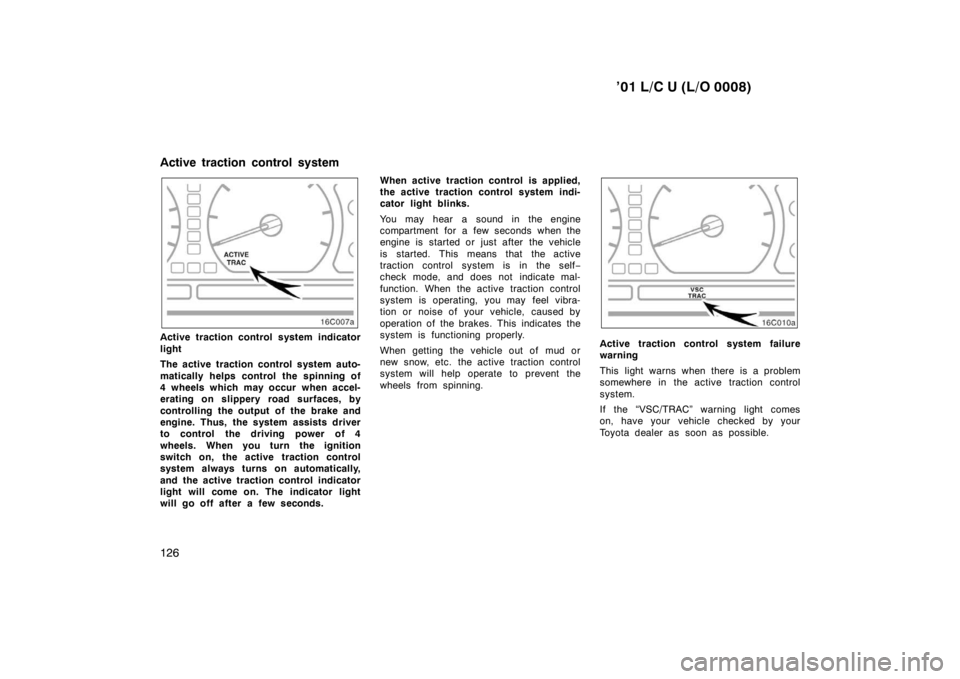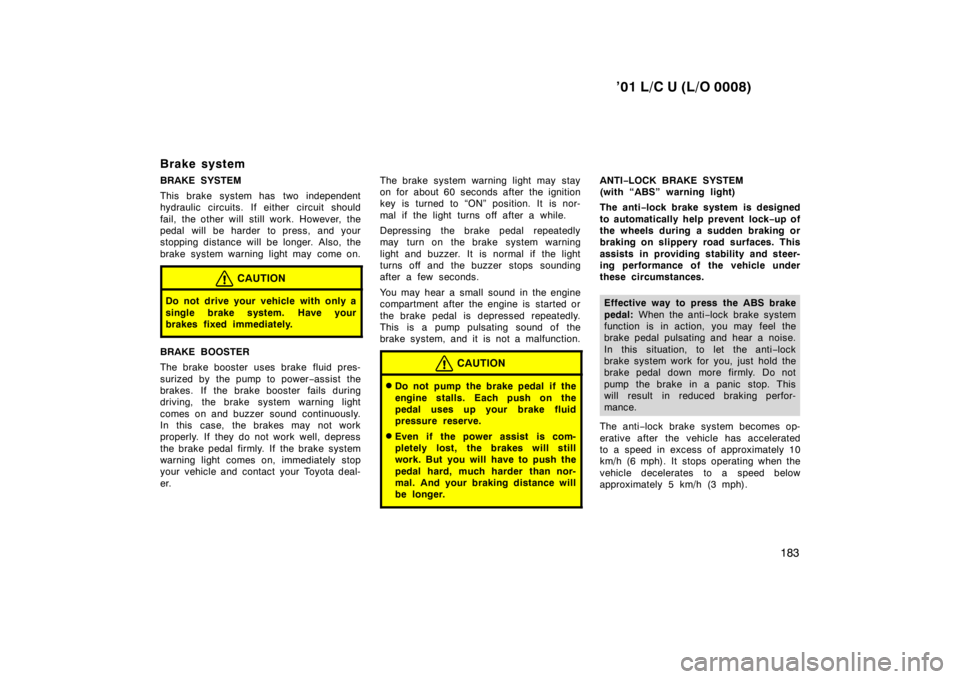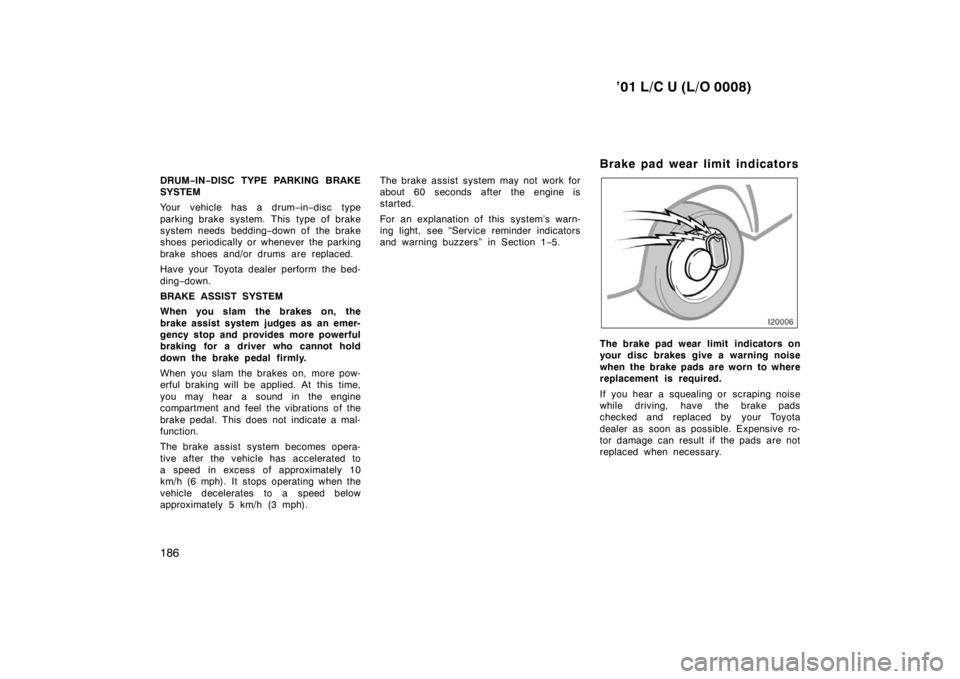2001 TOYOTA LAND CRUISER brakes
[x] Cancel search: brakesPage 46 of 142

’01 L/C U (L/O 0008)
126
Active traction control system indicator
light
The active traction control system auto-
matically helps control the spinning of
4 wheels which may occur when accel-
erating on slippery road surfaces, by
controlling the output of the brake and
engine. Thus, the system assists driver
to control the driving power of 4
wheels. When you turn the ignition
switch on, the active traction control
system always turns on automatically,
and the active traction control indicator
light will come on. The indicator light
will go off after a few seconds. When active traction control is applied,
the active traction control system indi-
cator light blinks.
You may hear a sound in the engine
compartment for a few seconds when the
engine is started or just after the vehicle
is started. This means that the active
traction control system is in the self
−
check mode, and does not indicate mal-
function. When the active traction control
system is operating, you may feel vibra-
tion or noise of your vehicle, caused by
operation of the brakes. This indicates the
system is functioning properly.
When getting the vehicle out of mud or
new snow, etc. the active traction control
system will help operate to prevent the
wheels from spinning.Active traction control system failure
warning
This light warns when there is a problem
somewhere in the active traction control
system.
If the “VSC/TRAC” warning light comes
on, have your vehicle checked by your
Toyota dealer as soon as possible.
Active traction control system
Page 48 of 142

’01 L/C U (L/O 0008)
128
The vehicle skid control system helps
provide comprehensive control of sys-
tems such as anti −lock brake, traction
control, engine control, etc. This sys-
tem automatically controls the output of
the brakes or engine to help prevent
the vehicle from skidding under adverse
conditions.
When you turn the ignition switch on, the
slip indicator light will come on. The slip
indicator light will go off after a few sec-
onds. If the vehicle is going to skid during driv-
ing, the slip indicator light flashes and an
alarm sounds intermittently.
The vehicle skid control system activates
when the vehicle speed is more than the
following speed. Four
−wheel drive control lever in “H”
15 km/h (9 mph)
. . . . . . . . . . . . . . . . . . . . . . . Four −wheel drive control lever in “L”
30 km/h (19 mph)
. . . . . . . . . . . . . . . . . . . . . . .
You may hear a sound in the engine
compartment for a few seconds when the
engine is started or just after the vehicle
is started. This means that the vehicle
skid control is in the self −check mode and
does not indicate a malfunction.Pushing the center differential lock button
automatically turns the vehicle skid control
system off. At this time, the “VSC OFF”
indicator comes on with the center differ-
ential lock indicator light. (For details, see
“Four −wheel drive system—(a)Four −wheel
drive control” in this section.)
Vehicle skid control system
Page 91 of 142

’01 L/C U (L/O 0008)183
Brake system
BRAKE SYSTEM
This brake system has two independent
hydraulic circuits. If either circuit should
fail, the other will still work. However, the
pedal will be harder to press, and your
stopping distance will be longer. Also, the
brake system warning light may come on.
CAUTION
Do not drive your vehicle with only a
single brake system. Have your
brakes fixed immediately.
BRAKE BOOSTER
The brake booster uses brake fluid pres-
surized by the pump to power
−assist the
brakes. If the brake booster fails during
driving, the brake system warning light
comes on and buzzer sound continuously.
In this case, the brakes may not work
properly. If they do not work well, depress
the brake pedal firmly. If the brake system
warning light comes on, immediately stop
your vehicle and contact your Toyota deal-
er. The brake system warning light may stay
on for about 60 seconds after the ignition
key is turned to “ON” position. It is nor-
mal if the light turns off after a while.
Depressing the brake pedal repeatedly
may turn on the brake system warning
light and buzzer. It is normal if the light
turns off and the buzzer stops sounding
after a few seconds.
You may hear a small sound in the engine
compartment after the engine is started or
the brake pedal is depressed repeatedly.
This is a pump pulsating sound of the
brake system, and it is not a malfunction.
CAUTION
�
Do not pump the brake pedal if the
engine stalls. Each push on the
pedal uses up your brake fluid
pressure reserve.
� Even if the power assist is com-
pletely lost, the brakes will still
work. But you will have to push the
pedal hard, much harder than nor-
mal. And your braking distance will
be longer.
ANTI −LOCK BRAKE SYSTEM
(with “ABS” warning light)
The anti −lock brake system is designed
to automatically help prevent lock −up of
the wheels during a sudden braking or
braking on slippery road surfaces. This
assists in providing stab ility and steer-
ing performance of the vehicle under
these circumstances.
Effective way to press the ABS brake
pedal: When the anti −lock brake system
function is in action, you may feel the
brake pedal pulsating and hear a noise.
In this situation, to let the anti −lock
brake system work for you, just hold the
brake pedal down more firmly. Do not
pump the brake in a panic stop. This
will result in reduced braking perfor-
mance.
The anti −lock brake system becomes op-
erative after the vehicle has accelerated
to a speed in excess of approximately 10
km/h (6 mph). It stops operating when the
vehicle decelerates to a speed below
approximately 5 km/h (3 mph).
Page 94 of 142

’01 L/C U (L/O 0008)
186
DRUM
−IN −DISC TYPE PARKING BRAKE
SYSTEM
Your vehicle has a drum −in −disc type
parking brake system. This type of brake
system n eeds bedding −down of the brake
shoes periodically or whenever the parking
brake shoes and/or drums are replaced.
Have your Toyota dealer perform the bed-
ding −down.
BRAKE ASSIST SYSTEM
When you slam the brakes on, the
brake assist system judges as an emer-
gency stop and provides more powerful
braking for a driver who cannot hold
down the brake pedal firmly.
When you slam the brakes on, more pow-
erful braking will be applied. At this time,
you may hear a sound in the engine
compartment and feel the vibrations of the
brake pedal. This does not indicate a mal-
function.
The brake assist system becomes opera-
tive after the vehicle has accelerated to
a speed in excess of approximately 10
km/h (6 mph). It stops operating when the
vehicle decelerates to a speed below
approximately 5 km/h (3 mph). The brake assist system may not work for
about 60 seconds after the engine is
started.
For an explanation of this system’s warn-
ing light, see “Service reminder indicators
and warning buzzers” in Section 1
−5. Brake pad wear limit indicators
The brake pad wear limit indicators on
your disc brakes give a warning noise
when the brake pads are worn to where
replacement is required.
If you hear a squealing or scraping noise
while driving, have the brake pads
checked and replaced by your Toyota
dealer as soon as possible. Expensive ro-
tor damage can result if the pads are not
replaced when necessary.
Page 109 of 142

’01 L/C U (L/O 0008)
238
INSIDE THE VEHICLE
Items listed below should be checked
regularly, e.g. while performing periodic
services, cleaning the vehicle, etc.
Lights
Make sure the headlights, stop lights, tail
lights, turn signal lights, and other lights
are all working. Check headlight aim.
Service reminder indicators and warning
buzzers
Check that all service reminder indicators
and warning buzzers function properly.
Steering wheel
Be alert for changes in steering condition,
such as hard steering or strange noise.
Seats
Check that all front seat controls such as
seat adjusters, seatback recliner, etc. op-
erate smoothly and that all latches lock
securely in any position. Check that the
head restraint move up and down smooth-
ly and that the locks hold securely in any
latched position. For folding
−down rear
seatbacks, swing −up rear seat cushions
and detachable third seats, check that the
latches lock securely. Seat belts
Check that the seat belt system such as
buckles, retractors and anchors operate
properly and smoothly. Make sure the belt
webbing is not cut, frayed, worn or dam-aged.
Accelerator pedal
Check the pedal for smooth operation and
uneven pedal effort or catching.
Brake pedal
Check the pedal for smooth operation and
that the pedal has the proper clearance.
Check the brake booster function.
Brakes
At a safe place, check that the brakes do
not pull to one side when applied.
Parking brake
Check that the lever has the proper travel
and that, on a safe incline, your vehicle
is held securely with only the parking
brake applied.
Automatic transmission ”Park” mecha-
nism
Check the lock release button of the se-
lector lever for proper and smooth opera-
tion. On a safe incline, check that your
vehicle is held securely with the selector
lever in ”P” position and all brakes re-
leased.
IN THE ENGINE COMPARTMENT
Items listed below should be checked
from time to time, e.g. each time when
refueling.
Washer fluid
Make sure there is sufficient fluid in the
tank. See Section 7
−3 for additional in-
formation.
Engine coolant level
Make sure the coolant level is between
the ”FULL” and ”LOW” lines on the see −
through reservoir when the engine is cold.
See Section 7 −2 for additional information.
Battery electrolyte level
Make sure the electrolyte level of all bat-
tery cells is between upper and lower lev-
el lines on the case. Add only distilled
water when replenishing. See Section 7 −3
for additional information.
Page 134 of 142

’01 L/C U (L/O 0008)
276
Oil type:
Standard differential
Hypoid gear oil API GL −5
Limited −slip differential
Hypoid gear oil for limited −slip differ-
ential API GL −5
Recommended oil viscosity: Above −18 �C (0 �F)
SAE 90
Below −18 �C (0 �F)
SAE 80W or 80W −90
CHASSIS LUBRICATION
Wheel bearings: Lithium base wheel bearing grease,
NLGI No.2
Front drive shaft thrust bushings: Synthetic oil and lithium soap base
chassis grease, NLGI No.1
Propeller shafts: Lithium base wheel bearing grease,
NLGI No.2 BRAKES
Minimum pedal clearance when depressed
with the force of 490 N (50 kgf, 110 lbf)
with the engine running, mm (in.):
116 (4.6)
Pedal free play, mm (in.): 1—6 (0.04—0.24)
Pad wear limit, mm (in.):
1.0 (0.04)
Lining wear limit, mm (in.): 1.0 (0.04)
Parking brake adjustment when pulled with
the force of 196 N (20 kgf, 44 lbf): 4—6 clicks
Fluid type: SAE J1703 or FMVSS No.116 DOT 3
STEERING
Wheel free play: Less than 40 mm (1.6 in.)
Power steering fluid type: Automatic transmission fluid DEXRON �
II
or III Tires
Tire size:
P275/70R16 114S
Tire pressure, kPa (kgf/cm 2
or bar, psi):
Normal driving Front 200 (2.0, 29)
Rear 220 (2.2, 32)
Trailer towing Front 200 (2.0, 29)
Rear 240 (2.4, 35)
Wheel size: 16 � 8JJ
Wheel nut torque, N·m (kgf·m, ft·lbf): 131 (13.4, 96.6)
NOTE: For a complete information on tires (e.g. replacing tires or replacing
wheels), see ”Checking tire pres-
sure” through ”Aluminum wheel
precautions” in Section 7 −2.